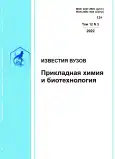Trichoderma spp. strains: growth and interaction at different temperatures
- Авторлар: Pisarevskaia V.A.1, Zhuravliova A.S.1, Minich M.V.1, Behbudzada N.B.1, Shagaev A.A.1, Markvichev N.S.1
-
Мекемелер:
- Mendeleev University of Chemical Technology of Russia
- Шығарылым: Том 12, № 3 (2022)
- Беттер: 417-423
- Бөлім: Physico-chemical biology
- URL: https://bakhtiniada.ru/2227-2925/article/view/301190
- DOI: https://doi.org/10.21285/2227-2925-2022-12-3-417-423
- ID: 301190
Дәйексөз келтіру
Толық мәтін
Аннотация
Негізгі сөздер
Авторлар туралы
V. Pisarevskaia
Mendeleev University of Chemical Technology of Russia
Email: pisarevskayaviola@mail.ru
A. Zhuravliova
Mendeleev University of Chemical Technology of Russia
Email: Sashka.zhuravliova@yandex.ru
M. Minich
Mendeleev University of Chemical Technology of Russia
Email: Mminich8@gmail.com
N. Behbudzada
Mendeleev University of Chemical Technology of Russia
Email: nnurlik@gmail.com
A. Shagaev
Mendeleev University of Chemical Technology of Russia
Email: shagaev.a.a@muctr.ru
N. Markvichev
Mendeleev University of Chemical Technology of Russia
Email: markvichev.n.s@muctr.ru
Әдебиет тізімі
- Kredics L., Hatvani L., Naeimi S., Körmöczi P., Manczinger L., Vágvölgyi C., et al. Biodiversity of the genus Hypocrea/Trichoderma in different habitats. In: Biotechnology and biology of Trichoderma. Elsevier; 2014, p. 3-24. https://doi.org/10.1016/B978-0-444-59576-8.00001-1.
- Kullnig C., Szakacs G., Kubicek C. P. Molecular identification of Trichoderma species from Russia, Siberia and the Himalaya. Mycological Research. 2000;104(9):1117-1125. https://doi.org/10.1017/S0953756200002604.
- Poveda J., Eugui D., Abril-Urias P. Could Trichoderma be a plant pathogen? Successful root colonization. In: Trichoderma. Rhizosphere biology. Sharma A., Sharma P. (eds.). Springer, Singapore; 2020, p. 35-59. http://dx.doi.org/10.1007/978-981-15-3321-1_3.
- Rubini M. R., Silva-Ribeiro R. T., Pomella A. W. V., Maki C. S., Araújo W. L., dos Santos D. R., et al. Diversity of endophytic fungal community of cacao (Theobroma cacao L.) and biological control of Crinipellis perniciosa, causal agent of Witches’ Broom Disease. International Journal of Biological Sciences. 2005;1(1):24-33. https://dx.doi.org/10.7150%2Fijbs.1.24.
- Kredics L., Jimenez G. L., Naeimi S., Czifra D., Urbán P., Manczinger L., et al. A challenge to mushroom growers: the green mould disease of cultivated champignons. In: Current research, technology and education topics in applied microbiology and microbial biotechnology. Méndez-Vilas A. (ed.). FORMATEX; 2010, p. 295-305.
- Höller U., Wright A. D., Matthee G. F., Konig G. M., Draeger S., Aust H.-J., et al. Fungi from marine sponges: diversity, biological activity and secondary metabolites. Mycological Research. 2000;104(11):1354-1365. http://dx.doi.org/10.1017/S0953756200003117.
- Zin N. A., Badaluddin N. A. Biological functions of Trichoderma spp. for agriculture applications. Annals of Agricultural Sciences. 2020;65(2):168-178. https://doi.org/10.1016/j.aoas.2020.09.003.
- Monte E. Understanding Trichoderma: between biotechnology and microbial ecology. International Journal of Microbiology. 2001;4(1):1-4. https://doi.org/10.1007/s101230100001.
- Sani M. N. H., Hasan M., Uddain J., Subramaniam S. Impact of application of Trichoderma and biochar on growth, productivity and nutritional quality of tomato under reduced N-P-K fertilization. Annals of Agricultural Sciences. 2020;65(1):107-115. https://doi.org/10.1016/j.aoas.2020.06.003.
- Lucini L., Colla G., Moreno M. B. M., Bernardo L., Cardarelli M., Terzi V., et al. Inoculation of Rhizoglomus irregulare or Trichoderma atroviride differentially modulates metabolite profiling of wheat root exudates. Phytochemistry. 2019;157:158-167. https://doi.org/10.1016/j.phytochem.2018.10.033.
- Caporale A. G., Sommella A., Lorito M., Lombardi N., Azam S. M. G. G., Pigna M., et al. Trichoderma spp. alleviate phytotoxicity in lettuce plants (Lactuca sativa L.) irrigated with arsenic-contaminated water. Journal of Plant Physiology. 2014;171(15):1378-1384. https://doi.org/10.1016/j.jplph.2014.05.011.
- Vargas J. T., Rodríguez-Monroy M., Meyer M. L., Montes-Belmont R., Sepúlveda-Jiménez G. Trichoderma asperellum ameliorates phytotoxic effects of copper in onion (Allium cepa L.). Environmental and Experimental Botany. 2017;136:85-93. https://doi.org/10.1016/j.envexpbot.2017.01.009.
- López-Mondéjar R., Ros M., Pascual J. A. Mycoparasitism-related genes expression of Trichoderma harzianum isolates to evaluate their efficacy as biological control agent. Biological Control. 2011;56(1):59-66. https://doi.org/10.1016/j.biocontrol.2010.10.003.
- Rajani P., Rajasekaran C., Vasanthakumari M. M., Olsson S. B., Ravikanth G., Shaanker R. U. Inhibition of plant pathogenic fungi by endophytic Trichoderma spp. through mycoparasitism and volatile organic compounds. Microbiological Research. 2021;242:126595. https://doi.org/10.1016/j.micres.2020.126595.
- Metz N., Hausladen H. Trichoderma spp. as potential biological control agent against Alternaria solani in potato. Biological Control. 2022;166:104820. https://doi.org/10.1016/j.biocontrol.2021.104820.
- Jambhulkar P. P., Raja M., Singh B., Katoch S., Kumar S., Sharma P. Potential native Trichoderma strains against Fusarium verticillioides causing post flowering stalk rot in winter maize. Crop Protection. 2021;152:105838. https://doi.org/10.1016/j.cropro.2021.105838.
- Carvalho D. D. C., Junior M. L., Martins I., Inglis P. W., Mello S. C. M. Biological control of Fusarium oxysporum f. sp. phaseoli by Trichoderma harzianum and its use for common bean seed treatment. Tropical Plant Pathology. 2014;39(5):384-391. https://doi.org/10.1590/S1982-56762014000500005.
- Cherif M., Benhamou N. Cytochemical aspects of chitin breakdown during the parasitic action of a Trichoderma sp. on Fusarium oxysporum f. sp. radicis-lycopersici. Phytopathology. 1990;80(12):1406-1414. https://doi.org/10.1094/PHYTO-80-1406.
- Shakeri J., Foster H. A. Proteolytic activity and antibiotic production by Trichoderma harzianum in relation to pathogenicity to insects. Enzyme and Microbial Technology. 2007;40(4):961-968. http://dx.doi.org/10.1016/j.enzmictec.2006.07.041.
- Juan Z., Ting L., Wei-Cheng L., Dian-Peng Z., Dan D., Hui-Ling W., et al. Transcriptomic insights into growth promotion effect of Trichoderma afroharzianum TM2-4 microbial agent on tomato plants. Journal of Integrative Agriculture. 2021;20(5):1266-1276. https://doi.org/10.1016/S2095-3119(20)63415-3.
- da Silva L. R., Valadares-Inglis M. C., Peixoto G. H. S., de Luccas B. E. G., Costa Muniz P. H. P., Magalhães D. M., et al. Volatile organic compounds emitted by Trichoderma azevedoi promote the growth of lettuce plants and delay the symptoms of white mold. Biological Control. 2021;152:104447. https://doi.org/10.1016/j.biocontrol.2020.104447.
- Rosyida V. T., Indrianingsih A. W., Maryana R., Wahono S. K. Effect of temperature and fermentation time of crude cellulase production by Trichoderma Reesei on straw substrate. Energy Procedia. 2015;65:368-371. https://doi.org/10.1016/j.egypro.2015.01.065.
Қосымша файлдар









